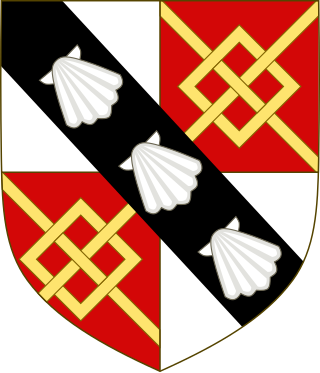
The Spencer family is an aristocratic family in the United Kingdom. From the 16th century, its members have held numerous titles, including the dukedom of Marlborough, the earldoms of Sunderland and Spencer, and the Churchill barony. Two prominent members of the family during the 20th century were Sir Winston Churchill and Diana, Princess of Wales.

Althorp is a Grade I listed stately home and estate in the civil parish of Althorp, in West Northamptonshire, England of about 13,000 acres (5,300 ha). By road it is about 6 miles (9.7 km) northwest of the county town of Northampton and about 75 miles (121 km) northwest of central London, situated between the villages of Great Brington and Harlestone. It has been held by the prominent aristocratic Spencer family for more than 500 years, and has been owned by Charles Spencer, 9th Earl Spencer since 1992. It was also the home of Lady Diana Spencer from her parents' divorce until her marriage to Charles, Prince of Wales.
Earl Spencer is a title in the Peerage of Great Britain that was created on 1 November 1765, along with the title Viscount Althorp, of Althorp in the County of Northampton, for John Spencer, 1st Viscount Spencer. He was a member of the prominent Spencer family and a great-grandson of the 1st Duke of Marlborough. Previously, he had been created Viscount Spencer, of Althorp in the County of Northampton, and Baron Spencer of Althorp, of Althorp in the County of Northampton, on 3 April 1761.
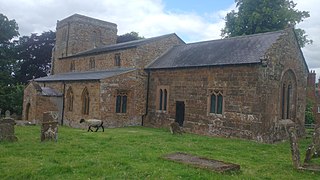
Wormleighton is a village in Warwickshire on top of Wormleighton Hill overlooking the River Cherwell, England. The population taken at the 2011 census was 183.

Great Brington is a village in Northamptonshire, England, in the civil parish of Brington, which at the 2011 Census had a population of about 200. St Mary the Virgin's church is the parish church.

Whichford is a village and civil parish in Warwickshire, England, about 5 miles (8 km) southeast of Shipston-on-Stour. The parish adjoins the county boundary with Oxfordshire and the village is about 4+1⁄2 miles (7 km) north of the Oxfordshire town of Chipping Norton.

Ilmington is a village and civil parish about 3.5 miles (5.6 km) north-west of Shipston-on-Stour and 8 miles (13 km) south of Stratford-upon-Avon in the Cotswolds in Warwickshire, England. The population of the civil parish taken at the 2011 census was 712. Ilmington is the highest village in Warwickshire and is at the foot of the Ilmington Downs, which is the highest point in Warwickshire. Residents are called "Ilmingtonians".

Brailes is a civil parish about 3 miles (5 km) east of Shipston-on-Stour in Warwickshire, England. It includes the two villages of Lower and Upper Brailes but is often referred to as one village as the two adjoin each other. The parish includes the village of Winderton about 1.5 miles (2.4 km) northeast of Brailes, and the deserted medieval village of Chelmscote about 3.5 miles (5.6 km) north of Brailes. The parish is bounded to the east by Ditchedge Lane and Beggars' Lane, which are a historic ridgeway that also forms part of the county boundary with Oxfordshire. The northeastern boundary is a minor road, part of which follows the course of a Roman road.

Althorp is a lost village within the grounds of the Althorp estate in the English county of Northamptonshire. The village is recorded in the Domesday Book. In the 15th century, the manor was held by the Catesby family who were probably responsible for clearing the settlement, for by 1505, the records show that there were no tenants. In 1508, the parish, including the cleared settlement of Althorp, was sold to John Spencer of Wormleighton in Warwickshire. By 1577, the land in the parish had been divided into four large sheep pastures. Althorp remains a civil parish.
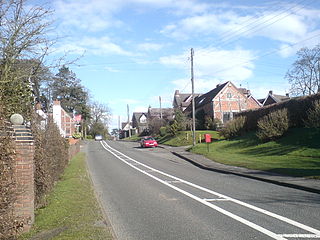
Claverdon is a village and civil parish in the Stratford-on-Avon district of Warwickshire, England, about 5 miles (8.0 km) west of the county town of Warwick. Claverdon's toponym comes from the Old English for "clover hill". The hill is near the centre of the scattered parish which included the township of Langley to the south, and formerly comprised the manors of Claverdon, Langley, Kington, and Songar.

Great Wolford is a village and civil parish in the Stratford-on-Avon district of Warwickshire, England. With the neighbouring parish of Little Wolford it is part of 'The Wolfords'.

Ratley is a village in the civil parish of Ratley and Upton, Stratford-on-Avon District, Warwickshire, England. The population of the civil parish in 2011 was 327. It is on the northwest side of the Edge Hill escarpment about 200 metres (660 ft) above sea level. The village is close to the county border with north Oxfordshire, some 7 miles northwest of Banbury, the closest town.

Tysoe is a civil parish in the Stratford-on-Avon District of Warwickshire, England. The parish is on the boundary with Oxfordshire, about 7+1⁄2 miles (12 km) northwest of Banbury. The parish includes the contiguous villages of Middle and Upper Tysoe and the separate hamlet of Lower Tysoe. The 2011 census recorded the parish population as 1,143.

Pillerton Hersey is a village and civil parish about 5.5 miles (9 km) north of Shipston-on-Stour in Warwickshire, England. The village is on a stream that flows northwest to join the River Dene. The 2011 Census recorded the parish's population as 170.

Sir Anthony Cope of Hanwell, near Banbury, was an English knight, author, principal chamberlain to Queen Catherine Parr, and sheriff of Oxfordshire and Berkshire.

Sir John Spencer was an English nobleman, politician, knight, sheriff, landowner, and Member of Parliament. He was an early member of the Spencer family.
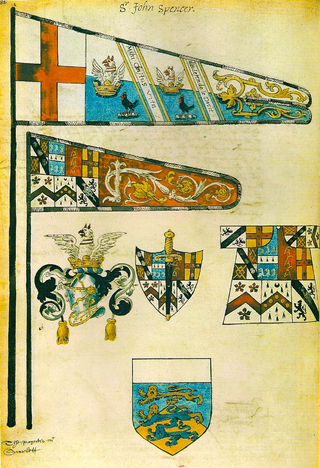
Sir John Spencer was an English nobleman, politician, landowner, sheriff, knight, and MP from the Spencer family.
Sir William Spencer was an English nobleman, politician, knight, landowner, and High Sheriff from the Spencer family.
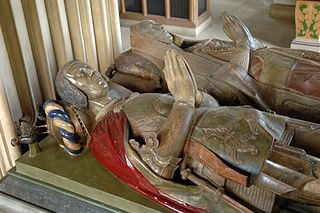
Sir John Spencer was an English nobleman who was widely admired, in his time, for his administration of the family estates. He inherited large estates in Northamptonshire and Warwickshire, and increased his lands and fortunes extensively. Spencer was also a politician, who served as member of parliament for several years, and was known for his support of Whig issues. He was also the Great-Great-Great-Great-Great-Great-Great-Great-Great-Great-Great-Great-Great Grandfather of British soldier and prime minister, Winston Churchill.

Sir William Cope PC was an English courtier who was Cofferer to Henry VII.




















